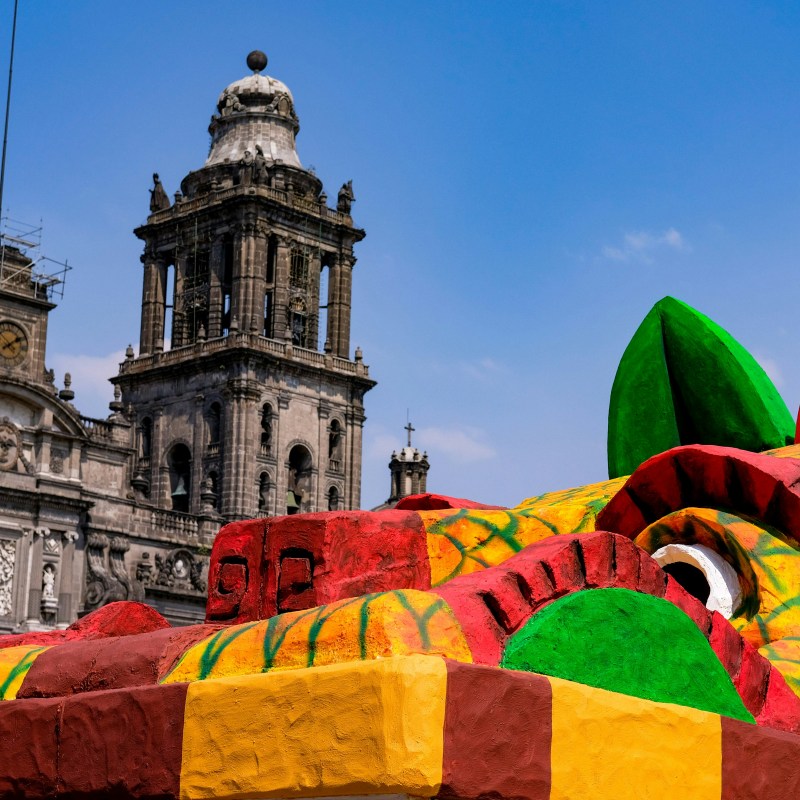
History is never as far away as we think.
Videos by TravelAwaits
If you take a fine-tooth comb to history, you’ll notice a few surprising intersections.
For example, though most wooly mammoths went extinct alongside North America’s mega-fauna around 10,000 years ago, some small populations held out.
In Russia’s Arctic Circle, small bands of wooly mammoths survived on a place called Wrangel Island until around 2000 BCE… which coincides with Ancient Egypt’s peak pyramid construction period. That means the Great Pyramid of Giza was built during the last years of the wooly.
But some overlapping history is a lot more direct. And some of it involves our world’s greatest wonders, from Yellowstone National Park to Machu Picchu.
Ever wonder which historical wonders coincide? Let’s dive in.
First up: the Aztecs and Oxford University.
Oxford & the Aztecs
Neither Oxford nor the Aztecs have concrete origins.
Oxford University in England was referenced as early as 1096, though it wasn’t formally founded until Henry II banned English scholars from studying at the University of Paris in 1167.
Around the same time, the Aztecs were gaining power in Central America. (By this time, the Mayan Empire had fallen.)
The Aztecs didn’t unite into a formal empire until three powerful tribes joined forces in 1428. And this empire would only keep its hold until Spanish conquistadors defeated Aztec rebellions in 1521.
So, what does that mean in terms of overlapping history? Oxford’s pre-Renaissance scholars were setting up the university’s colleges at the same time that Nahua peoples (future Aztecs) were venturing into central America and setting up city-states along the way.
Machu Picchu was built and abandoned during the Spanish conquest
Machu Picchu is one of our world’s bona fide wonders—one that travelers from around the world are willing to hike high into the Andes mountains to see.
It was only recently uncovered, too, when an archaeologist stumbled upon the site in 1911. And if you’ve ever seen images of this towering village, you know it’s easy to imagine Machu Picchu as a vestige of an ancient culture.
In reality, this Incan village was constructed early in the 1400s… and it was already abandoned by the time Spanish conquistadors arrived in the 1500s.
That means that Machu Picchu was built, occupied, and abandoned all within the first wave of Spanish colonial conquest of the Americas.
Spanish forces captured the leader of the Incan Empire, Atahualpa, before executing him in 1533. At the time, a civil war was tearing the Incan Empire apart, providing an ‘in’ for conquistadors.
By 1575, Spain’s colonial forces had control of the Andes and the Incan Empire… but European explorers and colonists didn’t stumble upon the then-abandoned Machu Picchu. For hundreds of years, it remained hidden from the general public, similar to Colombia’s Ciudad Perdida.
Spain already settled Santa Fe when the first English pilgrims arrived
When it comes to centuries-old sites in the United States, most people focus on the East Coast. That’s where colonial forces from Sweden, the Netherlands, France, and the UK battled it out before the US was formed in 1776.
But if you’ve read through the previous sections in this article, you might be one step ahead of me.
Spain’s colonial armies had already defeated the Aztecs and the Incas by the late 1500s… which predates the arrival of the US’s ‘first‘ pilgrims at Plymouth Rock in 1620.
While these pilgrims weren’t the first English settlers to arrive, many Americans consider them part of our cultural heritage.
So it’s understandably mind-blowing to know that Spain’s colonial forces already had a large estate (‘Palace of Governors’) built in Santa Fe, New Mexico at this time. That makes the Palace of Governors the oldest public building in the United States. Construction began in 1610, a cool decade before English pilgrims sailed the Atlantic.
Yellowstone Park & Germany & Italy
We tend to cover history in modern terms. In other words, we use modern politics and geography to inform how we speak of the past. For example, the Ancient Greeks called themselves Hellenes, a term that many wouldn’t immediately recognize.
The same is true for modern countries.
Italy and Germany are two examples that always pop up in my head, as both nations took on their modern form in the late 1800s—a whole century after the United States attained nationhood.
This was the case for many European states that were once composed of different territories and principalities. That makes both Italy and Germany very young in terms of official and modern statehood… almost as young as Yellowstone National Park, in fact.
Italy was formed in 1861. Ten years later, Germany was signed into existence in 1872. The birth of both nations only shortly precedes the establishment of Yellowstone National Park, which was formally protected in 1872.
